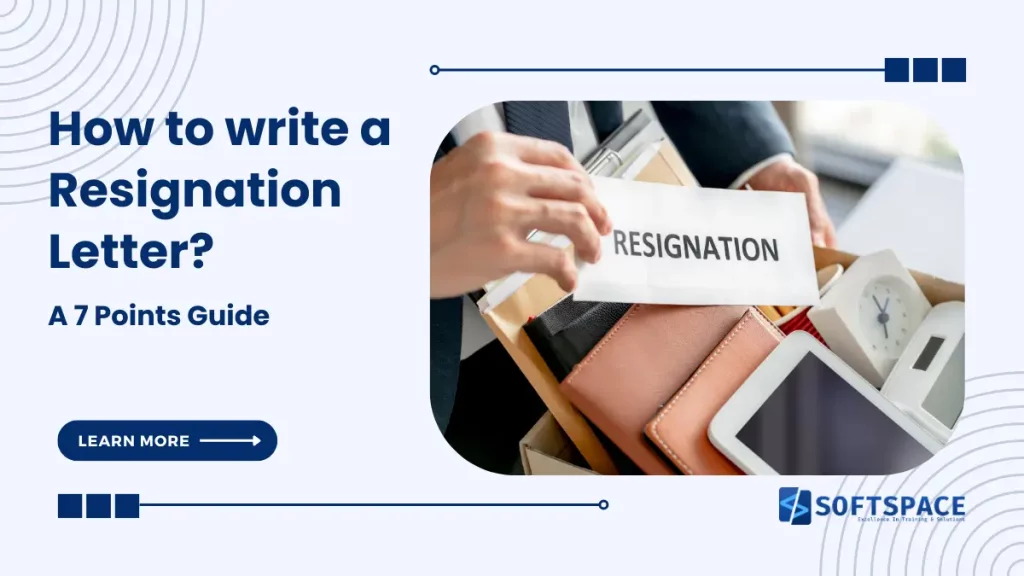So, you’ve landed that exciting new job and signed on the dotted line. Now, the final step before embarking on your new adventure is submitting a well-crafted resignation letter to your current employer.
While this isn’t the first step in quitting your job (that would be the face-to-face conversation with your boss), it’s a crucial one. Let’s explore how to create a polished, professional resignation letter that sets the right tone for your departure.
Table of Contents
Why Write a Resignation Letter?
A resignation letter is a formal document that:
- It officially notifies your employer of your intent to leave
- Specifies your last day of work
- Offers assistance during the transition period
- Expresses gratitude for the opportunities provided
- Serves as a record of your departure terms
The Key Elements of a Resignation Letter
- Date and Salutation
- Statement of Resignation
- Last Day of Employment
- Expression of Gratitude
- Offer of Assistance
- Well Wishes and Sign-off
How to write a Resignation Letter?
Moving on to bigger and better things? Here’s how to write a resignation letter that leaves a positive impression and sets you up for success in your next adventure.
This isn’t just about giving your notice; it’s a chance to end on a high note and maintain a strong relationship with your employer.
We’ll break it down into a four-step process, with some pro tips to make your resignation letter shine.
Step 1: State Your Intentions with Clarity
This is your chance to be direct. In the opening paragraph, simply state that you’re resigning from your position and provide your last day of work. No need to get creative or explain your reasons for leaving.
Example:
Dear [Manager Name],
Please accept this letter as formal notification that I am resigning from my position as [Your Job Title] at [Company Name], effective [Your Last Day of Work].
Step 2: Express Gratitude (Even if You’re Headed for the Hills)
Thank your employer for the opportunities you’ve been given. Briefly mention a few things you’ve learned or enjoyed about the job. This shows professionalism and keeps things positive. Remember, you never know when you might need a reference!
Example:
I’m grateful for the opportunity to have worked at [Company Name] for the past [Number] years. I’ve especially enjoyed [Mention a Specific Project or Responsibility] and appreciate the chance to develop my skills in [Mention a Specific Skill].
Step 3: Lend a Helping Hand
Let your employer know you’re willing to assist with the transition. You don’t need to go overboard, but offering to help train your replacement or wrap up your projects demonstrates your commitment and teamwork spirit.
Example:
I’m happy to assist with the transition in any way I can. I’m available to help train my replacement and ensure a smooth handover of my current projects.
Step 4: Sign Off with Well Wishes
Close the letter with a professional tone. Express your best wishes for the company’s continued success. If you’d like to stay in touch, you can include your personal contact information (think LinkedIn or email).
Example:
I wish you and the entire team at [Company Name] all the best in the future. Please feel free to stay in touch! You can reach me at [Your Personal Email Address] or connect with me on LinkedIn at [Your LinkedIn Profile URL].
Keeping it Classy: What to Omit From Your Resignation Letter
A resignation letter is your chance to bow out gracefully and potentially maintain a positive relationship with your employer. While the focus is on your departure, it’s equally important to consider what not to include. Here are some key things to leave out:
- Negativity: Resist the urge to vent about your frustrations with the company, colleagues, or your manager. This negativity can burn bridges and leave a bad taste in your employer’s mouth.
- Reasons for Leaving (in Detail): It’s okay to briefly mention you’re leaving for a new opportunity, but don’t go into detail about why you’re unhappy at your current job.
- Salary or Benefit Comparisons: Don’t brag about a higher salary or better benefits at your new position. This can come across as insensitive or boastful.
- Personal Information: Keep the letter focused on your resignation. Avoid including personal details about your future plans outside of work.
- Burning Bridges (except in extreme cases): Avoid bad-mouthing the company or colleagues. In very rare situations, like unsafe work conditions or illegal practices, you might consider a subtle mention but tread very carefully.
- Notice Period Negotiation: Don’t use the resignation letter to negotiate your notice period. Discuss this directly with your manager.
- Ultimatums or Demands: Don’t use the letter to make demands or issue ultimatums.
Remember, your resignation letter is part of your professional record. By maintaining a positive and professional tone, you can ensure a smooth exit and potentially open doors for future collaborations or recommendations.
How to write a registration letter? Check the example
Dear [Manager Name],
Please accept this letter as formal notification that I am resigning from my position as [Your Job Title] at [Company Name], effective [Your Last Day of Work].
I’m grateful for the opportunities for growth and development that I’ve had during my time at [Company Name]. I’ve especially enjoyed [Mention a Specific Project or Responsibility] and appreciate the chance to develop my skills in [Mention a Specific Skill].
I’m happy to assist with the transition in any way I can. I’m available to help train my replacement and ensure a smooth handover of my current projects.
I wish you and the entire team at [Company Name] all the best in the future. Please feel free to stay in touch! You can reach me at [Your Email Address] or connect with me on LinkedIn at [Your LinkedIn Profile URL].
Sincerely,
[Your Name]
3 more examples of How to write a resignation letter
Format 1: Accepting a New Opportunity (Formal)
Subject: Resignation – [Your Name]
Dear [Manager Name],
Please accept this letter as formal notification that I am resigning from my position as [Your Job Title] at [Company Name], effective [Your Last Day of Work].
I have recently accepted a new opportunity at another company that aligns more closely with my long-term career goals in [Your Field]. I’m incredibly grateful for the past [Number] years at [Company Name]. During my time here, I’ve had the privilege of [Mention Specific Achievements or Projects] and appreciate the support and guidance I’ve received from you and the team.
I’m committed to ensuring a smooth transition and am happy to assist with training my replacement and completing any outstanding tasks.
Thank you again for the opportunity to grow and develop my skills at [Company Name]. I wish you and the entire team continued success in the future. Please feel free to stay in touch! You can reach me at [Your Email Address] or connect with me on LinkedIn at [Your LinkedIn Profile URL].
Sincerely,
[Your Name]
Format 2: Resignation with Short Notice (More Informal)
Subject: Resignation – [Your Name]
Dear [Manager Name],
This email serves as formal notification that I will be resigning from my position as [Your Job Title] at [Company Name], effective [Your Last Day of Work] due to unforeseen circumstances.
I understand that this short notice may cause some inconvenience, and I sincerely apologize for any disruption it may create. I’m happy to assist with the handover process in any way possible during my remaining time here.
Thank you for the opportunity to work at [Company Name]. I’ve truly enjoyed my time here and appreciate the support I’ve received.
I wish you and the team all the best in the future.
Sincerely,
[Your Name]
Format 3: Resignation Due to Retirement (Warm and Appreciative)
Subject: Retirement – [Your Name]
Dear [Manager Name] and Team,
Please accept this letter as formal notification of my upcoming retirement from my position as [Your Job Title] at [Company Name], effective [Your Last Day of Work].
This decision has been a long time coming, and I’m incredibly grateful for the incredible [Number] years I’ve spent at [Company Name]. These past years have been filled with rewarding experiences, challenging projects, and the opportunity to work alongside a fantastic team. I’m particularly proud of [Mention Specific Achievements or Projects].
I will truly miss the camaraderie and collaborative spirit of [Company Name]. However, I’m looking forward to this new chapter in my life and spending more time with [Mention Retirement Plans].
I’m happy to assist with the transition in any way I can and am available to train my replacement or answer any questions during the coming months.
Thank you from the bottom of my heart for the opportunity to be a part of the [Company Name] family. I wish you all the best for continued success in the future.
Warmly,
[Your Name]
How to write a resignation letter? 5 Tips
- Maintain Professionalism: Even if you’re leaving for a not-so-great reason, keep the letter focused and professional. Don’t burn bridges by bad-mouthing colleagues or the company.
- Keep it Concise: A resignation letter is a formality, not a novel. Stick to the key points and avoid unnecessary detail. Aim for a single page.
- Proofread Carefully: Typos or grammatical errors can leave a bad impression. Proofread your letter thoroughly before submitting it.
- Consider Burning Bridges (Strategically): In rare cases, if the situation warrants it, you might consider subtly mentioning negative aspects of the work environment. However, do so with extreme caution and only if absolutely necessary (e.g., unsafe work conditions, illegal practices).
- Tailor it to the Situation: While the core structure remains similar, you can personalize the letter based on your reason for leaving. For example, if you’re leaving for a new opportunity, you might mention your excitement for the new role.
Conclusion
A well-written resignation letter is a professional courtesy that bridges the gap between your current role and your exciting new adventure. By following the tips and structure outlined above, you can ensure a smooth transition and leave a positive impression on your employer.
Remember, professionalism is key. So take a deep breath, craft a clear and concise letter, and move forward in your career with confidence.

13+ Yrs Experienced Career Counsellor & Skill Development Trainer | Educator | Digital & Content Strategist. Helping freshers and graduates make sound career choices through practical consultation. Guest faculty and Digital Marketing trainer working on building a skill development brand in Softspace Solutions. A passionate writer in core technical topics related to career growth.




